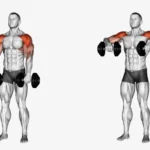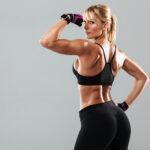Alternating Standing Dumbbell Curl: Exercise Overview
The alternating standing dumbbell curl is an effective isolation exercise designed to target the biceps brachii, with secondary engagement of the brachialis and forearms. By working each arm independently, this unilateral movement helps correct strength and size imbalances, promoting balanced arm development. Ideal for sculpting defined biceps and enhancing arm strength, the alternating standing curl is a staple in arm-focused workouts, upper-body sessions, or full-body routines. Its standing position challenges core stability, and the alternating pattern ensures focused muscle activation, making it suitable for lifters of all levels aiming for aesthetic and functional goals (Schoenfeld, 2010).
How to Perform the Alternating Standing Dumbbell Curl
- Stand with feet hip-width apart, holding a dumbbell in each hand with a supinated grip (palms facing up), arms relaxed by your sides, ensuring the dumbbells do not touch your body.
- Engage your core and slightly lift the dumbbells to take up the slack, creating initial tension in your biceps—this is your starting position.
- Starting with your weaker arm (often the left), curl the dumbbell upward toward your shoulder, keeping your elbow close to your torso and moving with control.
- Pause briefly at the top, squeezing your bicep for maximum contraction, then slowly lower the dumbbell back to the starting position, maintaining tension.
- Repeat with the opposite arm, alternating sides for the desired number of repetitions.
Tips for Optimal Performance
- Maintain Constant Tension: Keep both biceps engaged throughout the set, avoiding resting the dumbbells on your body or fully relaxing your arms (Schoenfeld, 2016).
- Minimize Body Movement: Keep your torso stationary and avoid swinging or leaning to ensure the biceps do the work, reducing momentum and injury risk (McGill, 2010).
- Control the Movement: Perform the curl and descent slowly to maximize time under tension and enhance bicep activation, avoiding rapid drops.
- Keep Elbows Tucked: Ensure your elbows remain close to your sides to isolate the biceps and prevent shoulder involvement (Wirth et al., 2016).
- Breathe Properly: Exhale as you curl the dumbbell upward and inhale as you lower it to support core stability and muscle oxygenation.
- Choose Appropriate Weight: Select dumbbells that allow you to maintain proper form for your target rep range (e.g., 8–12 reps per arm for hypertrophy) to avoid compensatory movements.
Sculpting balanced biceps with alternating curls? Dive into our Ultimate Guide to Muscle Groups for arm training.






